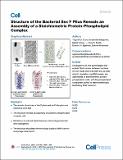Structure of the bacterial sex F pilus reveals an assembly of a stoichiometric protein-phospholipid complex
Abstract
Conjugative pili are widespread bacterial appendages that play important roles in horizontal gene transfer, in spread of antibiotic resistance genes, and as sites of phage attachment. Among conjugative pili, the F “sex” pilus encoded by the F plasmid is the best functionally characterized, and it is also historically the most important, as the discovery of F-plasmid-mediated conjugation ushered in the era of molecular biology and genetics. Yet, its structure is unknown. Here, we present atomic models of two F family pili, the F and pED208 pili, generated from cryoelectron microscopy reconstructions at 5.0 and 3.6 Å resolution, respectively. These structures reveal that conjugative pili are assemblies of stoichiometric protein-phospholipid units. We further demonstrate that each pilus type binds preferentially to particular phospholipids. These structures provide the molecular basis for F pilus assembly and also shed light on the remarkable properties of conjugative pili in bacterial secretion and phage infection.
Citation
Costa , T R D , langovan , A I , Ukleja , M , Redjez , A , Santini , J M , Smith , T K , Egelman , E H & Waksman , G 2016 , ' Structure of the bacterial sex F pilus reveals an assembly of a stoichiometric protein-phospholipid complex ' , Cell , vol. 166 , no. 6 , e10 , pp. 1436-1444 . https://doi.org/10.1016/j.cell.2016.08.025
Publication
Cell
Status
Peer reviewed
ISSN
0092-8674Type
Journal article
Description
This work was supported by Wellcome Trust grants 098302 to G.W. and 093228 to T.K.S. and NIH grant GM035269 to E.H.E.Collections
Items in the St Andrews Research Repository are protected by copyright, with all rights reserved, unless otherwise indicated.

